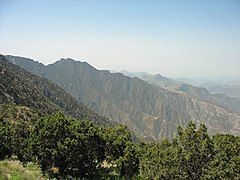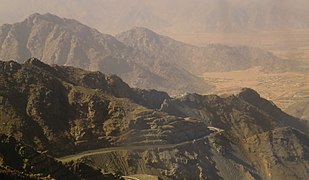Sarawat Mountains: Difference between revisions
Content deleted Content added
mNo edit summary |
|||
| Line 31: | Line 31: | ||
These mountains are mainly rocky though some contain vegetation. Many of the peaks are fairly young and jagged, but some are smoother from weathering. Nearing the Yemeni [[Saudi Arabia–Yemen border|border]], the Sarawat begin to spread into individual peaks, and the [[Hejaz]] turns from a cliff to a gradual ascent up to the Yemeni Plateau. In Yemen, the Sarawat are divided into the western and central highlands, where the western highlands receive plenty of precipitation, more than anywhere else in the peninsula, and the central highlands have the highest mountains in the peninsula. A very dramatic part of the Yemeni Sarawat are the [[Jabal Haraz|Haraz Mountains]],<ref name="CookFarmer2013">{{cite book |last1=Cook |first1=John |last2=Farmer |first2=G. Thomas |title=Climate Change Science: A Modern Synthesis |volume=1 – The Physical Climate |publisher=[[Springer Science+Business Media|Springer Science & Business Media]] |chapter=VI: Land and Its Climates |page=334 |isbn=978-9-4007-5757-8 |url=https://books.google.com/books?id=tbtEAAAAQBAJ |date=2013-01-12}}</ref> where a few peaks top {{convert|3,000|m|ft|abbr=off}}, but the descents and views from the mountains are staggering; some foots of mountains are only at {{convert|500|m|ft|abbr=off}} above sea level yet their peaks are at {{convert|2,800|-|3,300|m|ft|abbr=off}}. All of the mountains over {{convert|3,000|m|ft|abbr=off}} are located in Yemen, the highest of which is [[Jabal An-Nabi Shu'ayb]] near the capital [[Sana'a]]. At {{convert|3,666|m|ft|abbr=off}}, Jabal An-Nabi Shu'ayb is also the highest peak in Arabia.<ref name="Burrows2010"/><ref name="Laughlin2008"/> |
These mountains are mainly rocky though some contain vegetation. Many of the peaks are fairly young and jagged, but some are smoother from weathering. Nearing the Yemeni [[Saudi Arabia–Yemen border|border]], the Sarawat begin to spread into individual peaks, and the [[Hejaz]] turns from a cliff to a gradual ascent up to the Yemeni Plateau. In Yemen, the Sarawat are divided into the western and central highlands, where the western highlands receive plenty of precipitation, more than anywhere else in the peninsula, and the central highlands have the highest mountains in the peninsula. A very dramatic part of the Yemeni Sarawat are the [[Jabal Haraz|Haraz Mountains]],<ref name="CookFarmer2013">{{cite book |last1=Cook |first1=John |last2=Farmer |first2=G. Thomas |title=Climate Change Science: A Modern Synthesis |volume=1 – The Physical Climate |publisher=[[Springer Science+Business Media|Springer Science & Business Media]] |chapter=VI: Land and Its Climates |page=334 |isbn=978-9-4007-5757-8 |url=https://books.google.com/books?id=tbtEAAAAQBAJ |date=2013-01-12}}</ref> where a few peaks top {{convert|3,000|m|ft|abbr=off}}, but the descents and views from the mountains are staggering; some foots of mountains are only at {{convert|500|m|ft|abbr=off}} above sea level yet their peaks are at {{convert|2,800|-|3,300|m|ft|abbr=off}}. All of the mountains over {{convert|3,000|m|ft|abbr=off}} are located in Yemen, the highest of which is [[Jabal An-Nabi Shu'ayb]] near the capital [[Sana'a]]. At {{convert|3,666|m|ft|abbr=off}}, Jabal An-Nabi Shu'ayb is also the highest peak in Arabia.<ref name="Burrows2010"/><ref name="Laughlin2008"/> |
||
Geologically, the Sarawat |
Geologically, the Sarawat is part of the [[Arabian Shield]], and are made up mostly of [[volcanic rock]]. The western slopes end abruptly near the [[Red Sea]] coast, while the eastern side of the mountain range slopes downward more gently and is intersected by [[wadis]] that support [[agriculture]], especially in the southern reaches of the Sarawat, where the mountains face the [[monsoons]]. Among the cities located within the Sarawat is the Yemeni capital, [[San'a]], located near some of the Sarawat's highest peaks.<ref name="Burrows2010"/><ref name="Laughlin2008"/> |
||
==Wildlife== |
==Wildlife== |
||
Revision as of 02:32, 15 December 2020
| Sarawat Mountains | |
|---|---|
| Sarat | |
Sana'a, Yemen. Jabal An-Nabi Shu'ayb, the highest mountain in the Arabian Peninsula, is behind the mountain in the background. | |
| Highest point | |
| Peak | Jabal An-Nabi Shu'ayb, Yemen |
| Elevation | 3,666 m (12,028 ft) |
| Naming | |
| Native name | جِبَالُ ٱلسَّرَوَاتِ |
| Geography | |
| Countries | |
| Range coordinates | 18°16′02″N 42°22′05″E / 18.26722°N 42.36806°E |
The Sarawat Mountains (
Asir in southern Saudi Arabia, and extend to the Gulf of Aden in the south, running along the entire western coast of Yemen, in what used to be North Yemen, and extend eastwards into part of what used to be South Yemen, thus running parallel to the Gulf of Aden.[1][7]
Geology

These mountains are mainly rocky though some contain vegetation. Many of the peaks are fairly young and jagged, but some are smoother from weathering. Nearing the Yemeni
Sana'a. At 3,666 metres (12,028 feet), Jabal An-Nabi Shu'ayb is also the highest peak in Arabia.[1][7]
Geologically, the Sarawat is part of the
Wildlife
Ta'if in the Hejaz
The presence of the Arabian leopard was reported here.[9][10] Hamadryas baboons are present in both Yemen and Saudi Arabia.[11]
Gallery
-
A terraced side of one of the Haraz Mountains in Al Mahwit Governorate, near Jabal An-Nabi Shu'ayb
-
Jabal Sawdah in Saudi Arabia
-
Mountains ofTa'if
-
ISS-36 Night-time view of southwestern Saudi Arabia
See also
References
- ^ ISBN 978-0-8108-5528-1.
- ^ "ThePlace: Fifa Mountains in Jazan". Arab News. 2019-02-15. Retrieved 2019-02-17.
- ^ Overstreet, William Courtney (1977). Tertiary laterite of the As Sarat Mountains, Asir Province, Kingdom of Saudi Arabia. Vol. 2. Directorate General of Mineral Resources. pp. iii–2.
- ISBN 8-1702-2292-3.
- ISBN 978-1-4629-1365-7.
- ISBN 0-7614-7571-0.
- ^ ISBN 978-1-8416-2212-5.
- ISBN 978-9-4007-5757-8.
- ^ Judas, J.; Paillat, P.; Khoja, A.; Boug, A. (2006). "Status of the Arabian leopard in Saudi Arabia" (PDF). Cat News. Special Issue 1: 11–19.
- ^ Spalton, J. A. & Al-Hikmani, H. M. (2006). "The Leopard in the Arabian Peninsula – Distribution and Subspecies Status" (PDF). Cat News (Special Issue 1): 4–8.
- ^ Teller, Matthew (1 November 2012). "The Happy Ones". Saudi Aramco World. Retrieved 10 December 2018.
- ISBN 978-1-8416-2212-5.





![Jabal Nuqm or Jabal Nuqum in the area of Sana'a. Local legend has it that after the death of Noah, his son Shem built the city at the base of this mountain.[12]](http://upload.wikimedia.org/wikipedia/commons/thumb/3/32/%D8%AC%D8%A8%D9%84_%D9%86%D9%82%D9%85_-_panoramio.jpg/240px-%D8%AC%D8%A8%D9%84_%D9%86%D9%82%D9%85_-_panoramio.jpg)


